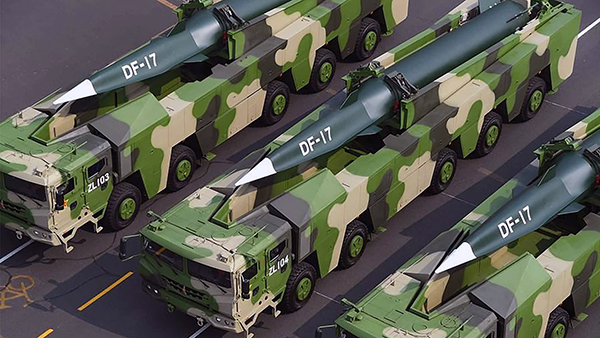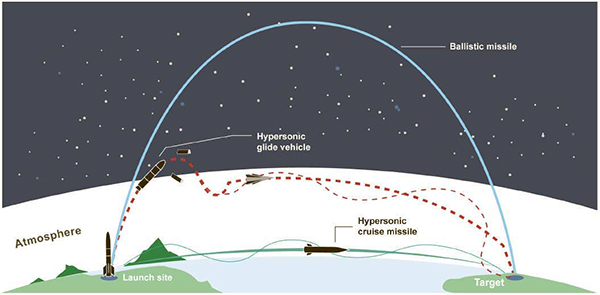
Mystery Over Type of Vehicle and Test
UK newspaper Financial Times, reported on 16 October, that China on July 27 and again on August 13, tested a nuclear-capable hypersonic glide vehicle, raising concern in Washington about Beijing’s advancing military capabilities. The vehicle circled the globe in low-orbit space before speeding towards its target. Hypersonic speeds are 5 or more times the speed of sound. The test has caught US intelligence by surprise, since the Pentagon the US had no information about China’s demonstrated capability.
A hypersonic glide vehicle launched by China fired the projectile over the South China Sea while moving at five times the speed of sound, the newspaper reported, citing people familiar with the intelligence.
Some military experts believe an air-to-air missile was fired, the newspaper said. Others thought it was a countermeasure that could hurt the ability of missile defence systems to knock out the hypersonic weapon, which can carry a nuclear warhead, in a battle.
“The missile missed its target by about two-dozen miles, according to three people briefed on the intelligence. But two said the test showed that China had made astounding progress on hypersonic weapons and was far more advanced than US officials realised. The test has raised new questions about why the US often underestimated China’s military modernisation,” the report said.
Chinese Statement
The FT report cited a security official, and another Chinese security expert close to the People’s Liberation Army, as saying the weapon was being developed by the China Academy of Aerospace Aerodynamics (CAAA), under the state-owned China Aerospace Science and Technology Corporation that makes missile systems and rockets for China’s space programme. Both sources reportedly said the vehicle was launched on a Long March rocket, which is used for the space programme.
China’s Foreign Ministry said in October the nation had tested “a routine spacecraft” to see if it was reusable. In an apparent effort to dismiss the idea the spacecraft launched anything, its spokesman added: “After separating from the spacecraft before its return, the supporting devices will burn up when they are falling in the atmosphere.”
The report quotes the China Academy of Launch Vehicle Technology as saying on an official social media account on July 19 that it had launched a Long March 2C rocket, its 77th launch. On August 24, it announced a 79th flight. But there was no announcement of a 78th launch, which sparked speculation about a secret launch, the report notes.
The Implications
The weapon could, in theory, fly over the South Pole. challenging for the US military because its missile defence systems are focused on the northern polar route.
If China’s tests of hypersonic weapons are confirmed, it would suggest that President Xi Jinping may be exploring orbital strikes as a way to counter American advancements in shooting down ballistic missiles before they can threaten the US homeland. Last year, the US Navy successfully intercepted a mock intercontinental ballistic missile.
“The US, Russia and China are all developing hypersonic weapons, including glide vehicles that are launched into space on a rocket but orbit the earth under their own momentum,” the report said.
Most of the hypersonic vehicles primarily use the scramjet technology. This extremely complex technology, which also needs to be able to handle high temperatures, makes the hypersonic systems extremely costly. It is all about how long can you sustain the systems at those extreme conditions. Scramjets are a category of engines designed to handle airflows of speeds in multiples of the speed of sound.
Mystery Deepens
Until now, reports had described a glide vehicle of the type intended to travel into space and traverse the globe in an orbital-like fashion before making its run through the atmosphere toward its target, what’s known as a Fractional Orbital Bombardment System, or FOBS. In common with certain Cold War-era concepts, FOBS offers key advantages in that it can launch strikes from the opposite direction that a large amount of existing early warning infrastructure is aimed at, doing so in a flight profile that is lower than what those systems are geared to provide early warning for.
Aside from the FOBS capability, a hypersonic glide vehicle already offers a less predictable flight path than what traditional ballistic missiles can provide, with the ability to make manoeuvres within the atmosphere. This includes during its run-in to its target, making it even harder to detect and defend against.
In an interview with CBS News, predating the latest revelation, General John Hyten, vice chairman of the Joint Chiefs of Staff, described the July 27 test as having involved “a long-range missile.” Hyten added: “It went around the world, dropped off a hypersonic glide vehicle that glided all the way back to China, that impacted a target in China.”
On the other hand, the White House declined to provide a comment on the FT story, instead offering a blanket statement on the original July 27 test, which it described as “concerning to us as it should be to all who seek peace and stability in the region and beyond.” Also approached by the newspaper for comment was the Chinese Embassy in London, which denied any knowledge of the weapons test having taken place.
DARPA experts are “unsure how China managed to fire countermeasures from a vehicle traveling at hypersonic speeds.” While the release of objects from vehicles flying at hypersonic speeds is an established practice in space — with intercontinental ballistic missiles (ICBMs) for example — the difference here is the claim that the payload was released in the atmosphere.
Atmospheric release of a payload at hypersonic speeds by a glide vehicle could well be indicative of a significant technological breakthrough, especially if it involved a guided missile. Either way, this kind of feat is by no means easy to achieve without destabilizing the mothership glider as it careens through the sky at thousands of miles per hour.
With all this in mind, it seems clear we have no real idea, at this stage, of what was ejected from the hypersonic vehicle, and for what reason. The FT adds that whatever was launched had “no obvious target of its own, before plunging into the [South China Sea].”
However, the latest revelations, on the surface at least, do seem to suggest the possibility of some type of reusable vehicle with a payload capability, perhaps similar to proposals for a bomber version of the U.S. Air Force’s X-20 Dyna-Soar that was developed by Boeing during the 1960s. This possibility now seems to be gaining ground among nuclear policy experts, as well.
Whatever the truth might be behind China’s July 27 test, and Beijing’s emerging hypersonic technologies — which include the in-service DF-17 that also makes use of a hypersonic glide vehicle — it’s clear that the country’s People’s Liberation Army Rocket Forces (PLARF) are making significant strides across a range of capabilities, including an apparently fast-expanding ICBM force.
Research in India
Hypersonic technology has been developed and tested by both DRDO and ISRO. Last September, DRDO successfully flight-tested the Hypersonic Technology Demonstrator Vehicle (HSTDV), with a capability to travel at 6 times the speed of sound. A solid rocket motor of Agni missile took it to an altitude of 30 km where the cruise vehicle separated as planned. The hypersonic combustion sustained and the cruise vehicle continued on its desired flight path at a velocity of six times the speed of sound for more than 20 seconds.
“The scramjet engine performed in a text book manner. With this successful demonstration, many critical technologies such as aerodynamic configuration for hypersonic manoeuvres, use of scramjet propulsion for ignition and sustained combustion at hypersonic flow, thermo-structural characterisation of high temperature materials, separation mechanism at hypersonic velocities etc. were proven.” DRDO had said in a statement.
Last December, an advanced Hypersonic Wind Tunnel (HWT) test facility of the DRDO was inaugurated in Hyderabad. It is a pressure vacuum-driven, enclosed free jet facility that simulates Mach 5 to 12.


















